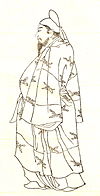Emperors of Japan
| No. | Portrait | Personal name | Posthumous name | Reign and era names [8] [9] [i] | Life details |
|---|---|---|---|---|---|
| 1 | 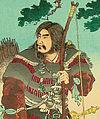 | Hikohohodemi 彦火火出見 | Emperor Jimmu 神武天皇 | 660–585 BC (75 years) | 721 or 711–585 BC (126 or 136 years) Son of kami Ugayafukiaezu. Claimed descent from the sun goddess, Amaterasu. Defeated Nagasunehiko in the Eastern Expedition to become emperor. Presumed legendary. [10] |
| 2 |  | Kamununakawamimi 神渟名川耳 | Emperor Suizei 綏靖天皇 | 581–549 BC (32 years) | 632–549 BC (83 years) Son of Emperor Jimmu. Presumed legendary. [11] |
| 3 |  | Shikitsuhikotamatemi 磯城津彦玉手看 | Emperor Annei 安寧天皇 | 549–511 BC (37 years) | 567–511 BC (56 years) Son of Emperor Suizei. Presumed legendary. [12] |
| 4 | 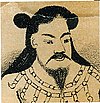 | Ōyamatohikosukitomo 大日本彦耜友 | Emperor Itoku 懿徳天皇 | 510–477 BC (33 years) | 553–477 BC (76 years) Son of Emperor Annei. Presumed legendary. [13] |
| 5 |  | Mimatsuhikokaeshine 観松彦香殖稲 | Emperor Kōshō 孝昭天皇 | 475–393 BC (82 years) | 506–393 BC (113 years) Son of Emperor Itoku. Presumed legendary. [14] |
| 6 |  | Yamatotarashihikokunioshihito 日本足彦国押人 | Emperor Kōan 孝安天皇 | 392–291 BC (101 years) | 427–291 BC (136 years) Son of Emperor Kōshō. Presumed legendary. [15] |
| 7 |  | Ōyamatonekohikofutoni 大日本根子彦太瓊 | Emperor Kōrei 孝霊天皇 | 290–215 BC (75 years) | 342–215 BC (127 years) Son of Emperor Kōan. Presumed legendary. [16] |
| 8 |  | Ōyamatonekohikokunikuru 大日本根子彦国牽 | Emperor Kōgen 孝元天皇 | 214–158 BC (56 years) | 273–158 BC (115 years) Son of Emperor Kōrei. Presumed legendary. [17] |
| 9 |  | Wakayamato Nekohiko Ōbibi 稚日本根子彦大日日 | Emperor Kaika 開化天皇 | 157–98 BC (59 years) | 208–98 BC (110 years) Son of Emperor Kōgen. Presumed legendary. [18] |
| 10 | 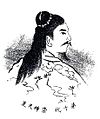 | Mimaki 御間城 | Emperor Sujin 崇神天皇 | 97–30 BC (67 years) | 148–30 BC (118 years) Son of Emperor Kaika. First emperor with a direct possibility of existence. [19] Still presumed legendary. [20] |
| 11 |  | Ikume 活目 | Emperor Suinin 垂仁天皇 | 29 BC–AD 70 (99 years) | 69 BC–AD 70 (127 years) Son of Emperor Sujin. Presumed legendary. [21] |
| 12 |  | Ōtarashihiko 大足彦 | Emperor Keikō 景行天皇 | 71–130 (59 years) | 13 BC–AD 130 (143 years) Son of Emperor Suinin. Presumed legendary. [22] |
| 13 | 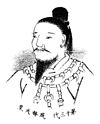 | Wakatarashihiko 稚足彦 | Emperor Seimu 成務天皇 | 131–190 (59 years) | 84–190 (106 years) Son of Emperor Keikō. Presumed legendary. [23] |
| 14 | 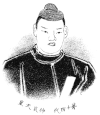 | Tarashinakatsuhiko 足仲彦 | Emperor Chūai 仲哀天皇 | 192–200 (8 years) | 149–200 (51 years) Grandson of Emperor Keikō; nephew of Emperor Seimu. First emperor to ascend the throne without being the son of the previous emperor. Died during a campaign against the Kumaso tribe. Presumed legendary. [24] |
| – |  | Okinagatarashi 息長帯比売 | Empress Jingū 神功皇后 | 201–269 (68 years) | 170–269 (99 years) Wife of Emperor Chūai; mother and regent of Emperor Ōjin. Not counted among the officially numbered emperors. Presumed legendary. [25] |
| 15 | 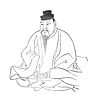 | Homutawake 誉田別 | Emperor Ōjin 応神天皇 | 270–310 (40 years) | 201–310 (109 years) Son of Emperor Chūai and Empress Jingū. Deified in Shinto and Buddhism in Japan as Hachiman. Presumed legendary. [26] |
| 16 |  | Ohosazaki 大鷦鷯 | Emperor Nintoku 仁徳天皇 | 313–399 (86 years) | 290–399 (108–109 years) Son of Emperor Ōjin. Presumed legendary. [27] |
| 17 | 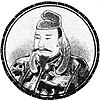 | Ōenoizahowake 大兄去来穂別 | Emperor Richū 履中天皇 | 400–405 (5 years) | 336–405 (69 years) Son of Emperor Nintoku. Presumed legendary. [28] |
| 18 |  | Mizuhawake 瑞歯別 | Emperor Hanzei 反正天皇 | 406–410 (5 years) | 352–411 (59 years) Son of Emperor Nintoku; younger brother of Emperor Richū. Presumed legendary. [29] |
| 19 | 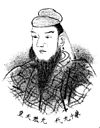 | Oasatsuma Wakugo no Sukune 雄朝津間稚子宿禰 | Emperor Ingyō 允恭天皇 | 411–453 (42 years) | 376–453 (77 years) Son of Emperor Nintoku; younger brother of Emperor Richū and Emperor Hanzei. Presumed legendary. [30] |
| 20 | 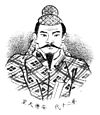 | Anaho 穴穂 | Emperor Ankō 安康天皇 | 453–456 (3 years) | 401–456 (55 years) Son of Emperor Ingyō. Assassinated by Prince Mayowa. Presumed legendary. [31] |
| 21 | 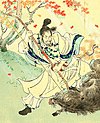 | Ōhatuse no Wakatakeru 大泊瀬稚武 | Emperor Yūryaku 雄略天皇 | 456–479 (23 years) | 418–479 (61 years) Son of Emperor Ingyō; younger brother of Emperor Ankō. Presumed legendary. [32] |
| 22 |  | Shiraka 白髪 | Emperor Seinei 清寧天皇 | 480–484 (4 years) | 444–484 (40 years) Son of Emperor Yūryaku. Presumed legendary. [33] |
| 23 |  | Woke 弘計 | Emperor Kenzō 顕宗天皇 | 485–487 (2 years) | 450–487 (37 years) Grandson of Emperor Richū; cousin and adopted son of Emperor Seinei. Presumed legendary. [34] |
| 24 | 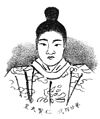 | Oke 億計 | Emperor Ninken 仁賢天皇 | 488–498 (10 years) | 448–498 (50 years) Grandson of Emperor Richū; cousin and adopted son of Emperor Seinei; older brother of Emperor Kenzō. Presumed legendary. [35] |
| 25 |  | Ohatsuse no Wakasazaki 小泊瀬稚鷦鷯 | Emperor Buretsu 武烈天皇 | 499–506 (7 years) | 489–506 (17 years) Son of Emperor Ninken. Presumed legendary. [36] |
| 26 | 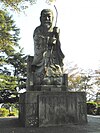 | Ohodo [ii] 袁本杼 | Emperor Keitai 継体天皇 | 507–531 (24 years) | 450–531 (81 years) 5th-generation grandson of Emperor Ōjin. Became emperor at the recommendation of Ōtomo no Kanamura. Possible founder of a new dynasty. Presumed legendary. [37] [38] |
| 27 |  | Magari 勾 | Emperor Ankan 安閑天皇 | 534–535 (1 year) | 466–535 (69 years) Son of Emperor Keitai. Presumed legendary. [39] |
| 28 |  | Hinokuma-no-takata 檜隈高田 | Emperor Senka 宣化天皇 | 536–539 (3 years) | 467–539 (72 years) Son of Emperor Keitai; younger brother of Emperor Ankan. Presumed legendary. [40] |
| 29 |  | Amekunioshiharakihironiwa 天国排開広庭 | Emperor Kinmei 欽明天皇 | 540–571 (31 years) | 509–571 (62 years) Son of Emperor Keitai; younger brother of Emperor Ankan and Emperor Senka. First historically verifiable emperor. [5] [41] |
| 30 | 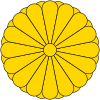 | Nunakura no Futotamashiki 渟中倉太珠敷 | Emperor Bidatsu 敏達天皇 | 572–585 (13 years) | 538–585 (47 years) Son of Emperor Kinmei. [42] |
| 31 |  | Tachibana no Toyohi 橘豊日 | Emperor Yōmei 用明天皇 | 586–587 (1 year) | 517–587 (70 years) Son of Emperor Kinmei; half-brother of Emperor Bidatsu. [43] |
| 32 |  | Hatsusebe 泊瀬部 | Emperor Sushun 崇峻天皇 | 587–592 (5 years) | 522–592 (70 years) Son of Emperor Kinmei; half-brother of Emperor Bidatsu and Emperor Yōmei. Made emperor by Soga no Umako following the Soga–Mononobe conflict. Assassinated by Yamatonoaya no Koma on the orders of Soga no Umako. [44] |
| 33 | 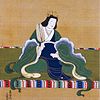 | Nukatabe 額田部 | Empress Suiko 推古天皇 | 593–628 (35 years) | 554–628 (74 years) Daughter of Emperor Kinmei; half-sister and wife of Emperor Bidatsu. First non-legendary female monarch. Prince Shōtoku acted as her regent. [45] |
| 34 |  | Tamura 田村 | Emperor Jomei 舒明天皇 | 629–641 (12 years) | 593–641 (48 years) Grandson of Emperor Bidatsu; great nephew of Empress Suiko. [46] |
| 35 | 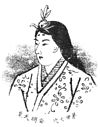 | Takara 宝 | Empress Kōgyoku 皇極天皇 | 642–645 (3 years) | 594–661 (67 years) Great-granddaughter of Emperor Bidatsu; wife of Emperor Jomei. First reign. Abdicated as a result of the Isshi incident. [47] |
| 36 |  | Karu 軽 | Emperor Kōtoku 孝徳天皇 | 645–654 (9 years) Taika, Hakuchi | 597–654 (57 years) Great-grandson of Emperor Bidatsu; younger brother of Empress Kōgyoku. First era name assigned. [48] |
| 37 |  | Takara 宝 | Empress Saimei 斉明天皇 | 655–661 (6 years) | 594–661 (67 years) Older sister of Emperor Kōtoku. Previously reigned as Empress Kōgyoku. Second reign. [49] |
| 38 |  | Kazuraki 葛城 | Emperor Tenji 天智天皇 | 662–672 (10 years) | 626–672 (46 years) Son of Emperor Jomei and Empress Kōgyoku. [50] |
| 39 |  | Ōtomo [iii] 大友 | Emperor Kōbun 弘文天皇 | 672 (8 months) | 648–672 (24 years) Son of Emperor Tenji. Deposed and committed suicide during the Jinshin War. Not recognized as emperor until 1870. [51] |
| 40 |  | Ōama 大海人 | Emperor Tenmu 天武天皇 | 673–686 (14 years) Shuchō | 622–686 (56 years) Son of Emperor Jomei and Empress Kōgyoku; younger brother of Emperor Tenji. Deposed his nephew, Emperor Kōbun, during the Jinshin War. [52] |
| 41 | 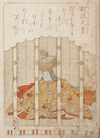 | Unonosarara [iv] 鸕野讚良 | Empress Jitō 持統天皇 | 687–697 (10 years) [v] | 646–703 (57 years) Daughter of Emperor Tenji; niece and wife of Emperor Tenmu. Abdicated. [53] |
| 42 | 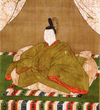 | Karu [vi] 珂瑠 | Emperor Monmu 文武天皇 | 697–707 (10 years) Taihō, Keiun | 683–707 (24 years) Grandson of Emperor Tenmu and Empress Jitō. [54] |
| 43 | 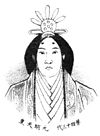 | Ahe [vii] 阿閇 | Empress Genmei 元明天皇 | 707–715 (8 years) Keiun, Wadō | 660–721 (61 years) Daughter of Emperor Tenji; half-sister of Empress Jitō; mother of Emperor Monmu. Abdicated. [55] |
| 44 |  | Hidaka [viii] 氷高 | Empress Genshō 元正天皇 | 715–724 (9 years) Reiki, Yōrō | 681–748 (67 years) Daughter of Empress Genmei; elder sister of Emperor Monmu. Only instance of an empress regnant inheriting the throne from another empress regnant. Abdicated. [56] |
| 45 | 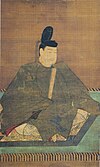 | Obito 首 | Emperor Shōmu 聖武天皇 | 724–749 (25 years) Jinki, Tenpyō, Tenpyō-kanpō | 701–756 (55 years) Son of Emperor Monmu; nephew of Empress Genshō. Abdicated. [57] |
| 46 |  | Abe 阿倍 | Empress Kōken 孝謙天皇 | 749–758 (9 years) Tenpyō-kanpō, Tenpyō-shōhō, Tenpyō-hōji | 718–770 (52 years) Daughter of Emperor Shōmu. First reign. Abdicated. [58] |
| 47 |  | Ōi 大炊 | Emperor Junnin 淳仁天皇 | 758–764 (6 years) Tenpyō-hōji | 733–765 (32 years) Grandson of Emperor Tenmu; cousin of Empress Kōken. Deposed. Posthumously named emperor in 1870. [59] |
| 48 |  | Abe 阿倍 | Empress Shōtoku 称徳天皇 | 764–770 (6 years) Tenpyō-hōji, Tenpyō-jingo, Jingo-keiun | 718–770 (52 years) Deposed her cousin, Emperor Junnin. Previously reigned as Empress Kōken. Second reign. [60] |
| 49 |  | Shirakabe 白壁 | Emperor Kōnin 光仁天皇 | 770–781 (11 years) Hōki, Ten'ō | 708–782 (73 years) Grandson of Emperor Tenji; brother-in-law of Empress Shōtoku. Abdicated. [61] |
| 50 |  | Yamabe 山部 | Emperor Kanmu 桓武天皇 | 781–806 (25 years) Ten'ō, Enryaku | 736–806 (70 years) Son of Emperor Kōnin. [62] |
| 51 |  | Ate 安殿 | Emperor Heizei 平城天皇 | 806–809 (3 years) Daidō | 773–824 (51 years) Son of Emperor Kanmu. Abdicated. [63] |
| 52 | 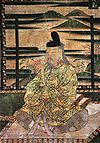 | Kamino 神野 | Emperor Saga 嵯峨天皇 | 809–823 (14 years) Daidō, Kōnin | 785–842 (57 years) Son of Emperor Kanmu; younger brother of Emperor Heizei. Abdicated. [64] |
| 53 | 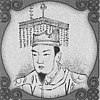 | Ōtomo 大伴 | Emperor Junna 淳和天皇 | 823–833 (10 years) Kōnin, Tenchō | 786–840 (54 years) Son of Emperor Kanmu; younger brother of Emperor Heizei and Emperor Saga. Abdicated. [65] |
| 54 | 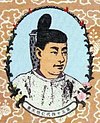 | Masara 正良 | Emperor Ninmyō 仁明天皇 | 833–850 (17 years) Tenchō, Jōwa, Kashō | 808–850 (41 years) Son of Emperor Saga; nephew and adopted son of Emperor Junna. [66] |
| 55 |  | Michiyasu 道康 | Emperor Montoku 文徳天皇 | 850–858 (8 years) Kashō, Ninju, Saikō, Ten'an | 827–858 (31 years) Son of Emperor Ninmyō. [67] |
| 56 | 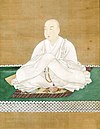 | Korehito 惟仁 | Emperor Seiwa 清和天皇 | 858–876 (18 years) Ten'an, Jōgan | 850–881 (30 years) Son of Empereor Montoku. Abdicated. [68] |
| 57 | 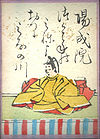 | Sadaakira 貞明 | Emperor Yōzei 陽成天皇 | 876–884 (8 years) Jōgan, Gangyō | 869–949 (80 years) Son of Emperor Seiwa. Deposed by Fujiwara no Mototsune. [69] |
| 58 | 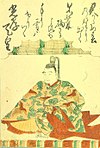 | Tokiyasu 時康 | Emperor Kōkō 光孝天皇 | 884–887 (3 years) Gangyō, Ninna | 830–887 (57 years) Son of Emperor Ninmyō; great uncle of Emperor Yōzei. Became emperor at the recommendation of Fujiwara no Mototsune. [70] |
| 59 |  | Sadami 定省 | Emperor Uda 宇多天皇 | 887–897 (10 years) Ninna, Kanpyō | 866–931 (65 years) Son of Emperor Kōkō. Abdicated. [71] |
| 60 | 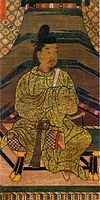 | Atsuhito [ix] 敦仁 | Emperor Daigo 醍醐天皇 | 897–930 (33 years) Kanpyō, Shōtai, Engi, Enchō | 884–930 (46 years) Son of Emperor Uda. Abdicated. [72] |
| 61 |  | Yutaakira [x] 寛明 | Emperor Suzaku 朱雀天皇 | 930–946 (16 years) Enchō, Jōhei, Tengyō | 921–952 (30 years) Son of Emperor Daigo. Abdicated. [73] |
| 62 |  | Nariakira 成明 | Emperor Murakami 村上天皇 | 946–967 (21 years) Tengyō, Tenryaku, Tentoku, Ōwa, Kōhō | 924–967 (42 years) Son of Emperor Daigo; younger brother of Emperor Suzaku. [74] |
| 63 |  | Norihara 憲平 | Emperor Reizei 冷泉天皇 | 967–969 (2 years) Kōhō, Anna | 949–1011 (62 years) Son of Emperor Murakami. Abdicated. [75] |
| 64 |  | Morihira 守平 | Emperor En'yū 円融天皇 | 969–984 (15 years) Anna, Tenroku, Ten'en, Jōgen, Tengen, Eikan | 958–991 (32 years) Son of Emperor Murakami; younger brother of Emperor Reizei. Abdicated. [76] |
| 65 |  | Morosada 師貞 | Emperor Kazan 花山天皇 | 984–986 (2 years) Eikan, Kanna | 968–1008 (39 years) Son of Emperor Reizei; nephew of Emperor En'yū. Abdicated. [77] |
| 66 |  | Kanehito 懐仁 | Emperor Ichijō 一条天皇 | 986–1011 (25 years) Kanna, Eien, Eiso, Shōryaku, Chōtoku, Chōhō, Kankō | 980–1011 (31 years) Son of Emperor Emperor En'yū. Abdicated. [78] |
| 67 |  | Okisada [xi] 居貞 | Emperor Sanjō 三条天皇 | 1011–1016 (5 years) Kankō, Chōwa | 975–1017 (42 years) Son of Emperor Reizei; half-brother of Emperor Kazan; cousin of Emperor Ichijō. Abdicated. [79] |
| 68 |  | Atsuhira [xii] 敦成 | Emperor Go-Ichijō 後一条天皇 | 1016–1036 (20 years) Chōwa, Kannin, Jian, Manju, Chōgen | 1008–1036 (27 years) Son of Emperor Ichijō; cousin of Emperor Sanjō. [80] |
| 69 |  | Atsunaga 敦良 | Emperor Go-Suzaku 後朱雀天皇 | 1036–1045 (9 years) Chōgen, Chōryaku, Chōkyū, Kantoku | 1009–1045 (37 years) Son of Emperor Ichijō; younger brother of Emperor Go-Ichijō. Abdicated. [81] |
| 70 |  | Chikahito 親仁 | Emperor Go-Reizei 後冷泉天皇 | 1045–1068 (23 years) Kantoku, Eishō, Tengi, Kōhei, Jiryaku | 1025–1068 (42 years) Son of Emperor Go-Suzaku. [82] |
| 71 |  | Takahito 尊仁 | Emperor Go-Sanjō 後三条天皇 | 1068–1073 (5 years) Jiryaku, Enkyū | 1032–1073 (40 years) Son of Emperor Go-Suzaku; half-brother of Emperor Go-Reizei. Abdicated. [83] |
| 72 |  | Sadahito 貞仁 | Emperor Shirakawa 白河天皇 | 1073–1087 (14 years) Enkyū, Jōhō, Jōryaku, Eihō, Ōtoku | 1053–1129 (76 years) Son of Emperor Go-Sanjō. Abdicated. [84] |
| 73 | 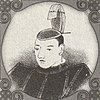 | Taruhito [xiii] 善仁 | Emperor Horikawa 堀河天皇 | 1087–1107 (20 years) Kanji, Kahō, Eichō, Jōtoku, Kōwa, Chōji, Kajō | 1079–1107 (28 years) Son of Emperor Shirakawa. [85] |
| 74 |  | Munehito 宗仁 | Emperor Toba 鳥羽天皇 | 1107–1123 (16 years) Kajō, Tennin, Ten'ei, Eikyū, Gen'ei, Hōan | 1103–1156 (53 years) Son of Emperor Horikawa. Forced to abdicate by Emperor Shirakawa. [86] |
| 75 |  | Akihito 顕仁 | Emperor Sutoku 崇徳天皇 | 1123–1142 (19 years) Hōan, Tenji, Daiji, Tenshō, Chōshō, Hōen, Eiji | 1119–1164 (45 years) Son of Emperor Toba. Abdicated. Attempted to depose Emperor Go-Shirakawa during the Hōgen rebellion. [87] |
| 76 |  | Narihito 体仁 | Emperor Konoe 近衛天皇 | 1142–1155 (13 years) Eiji, Kōji, Ten'yō, Kyūan, Ninpei, Kyūju | 1139–1155 (16 years) Son of Emperor Toba; half-brother of Emperor Sutoku. [88] |
| 77 |  | Masahito 雅仁 | Emperor Go-Shirakawa 後白河天皇 | 1155–1158 (3 years) Kyūju, Hōgen | 1127–1192 (64 years) Son of Emperor Toba; younger brother of Emperor Sutoku; half-brother of Emperor Konoe. Abdicated. [89] |
| 78 |  | Morihito 守仁 | Emperor Nijō 二条天皇 | 1158–1165 (7 years) Hōgen, Heiji, Eiryaku, Ōhō, Chōkan | 1143–1165 (22 years) Son of Emperor Go-Shirakawa. Abdicated. [90] |
| 79 |  | Nobuhito [xiv] 順仁 | Emperor Rokujō 六条天皇 | 1165–1168 (3 years) Chōkan, Eiman, Nin'an | 1164–1176 (11 years) Son of Emperor Nijō. Deposed by Emperor Go-Shirakawa. [91] |
| 80 | 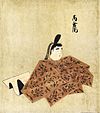 | Norihito [xv] 憲仁 | Emperor Takakura 高倉天皇 | 1168–1180 (12 years) Nin'an, Kaō, Jōan, Angen, Jishō | 1161–1181 (19 years) Son of Emperor Go-Shirakawa; half-brother of Emperor Nijō; uncle of Emperor Rokujō. Forced to abdicate by Taira no Kiyomori. [92] |
| 81 |  | Tokihito [xvi] 言仁 | Emperor Antoku 安徳天皇 | 1180–1185 (5 years) Jishō, Yōwa, Juei, Genryaku | 1178–1185 (6 years) Son of Emperor Takakura. Died at the Battle of Dan-no-ura during the Genpei War. [93] |
| 82 |  | Takahira [xvii] 尊成 | Emperor Go-Toba 後鳥羽天皇 | 1183–1198 (15 years) Juei, Genryaku, Bunji, Kenkyū | 1180–1239 (58 years) Son of Emperor Takakura; half-brother of Emperor Antoku. Made emperor by Emperor Go-Shirakawa during the Genpei War. Kamakura shogunate turned the emperor into a figurehead. Abdicated. Attempted to overthrow the Kamakura shogunate during the Jōkyū War. [94] |
| 83 |  | Tamehito 為仁 | Emperor Tsuchimikado 土御門天皇 | 1198–1210 (12 years) Kenkyū, Shōji, Kennin, Genkyū, Ken'ei, Jōgen | 1196–1231 (35 years) Son of Emperor Go-Toba. Persuaded by Emperor Go-Toba to abdicate. Exiled following the Jōkyū War. [95] |
| 84 |  | Morinari 守成 | Emperor Juntoku 順徳天皇 | 1210–1221 (11 years) Jōgen, Kenryaku, Kempo, Jōkyū | 1197–1242 (44 years) Son of Emperor Go-Toba; half-brother of Emperor Tsuchimikado. Forced to abdicate following the Jōkyū War. [96] |
| 85 | 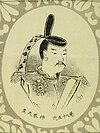 | Kanenari 懐成 | Emperor Chūkyō 仲恭天皇 | 1221 (2 months) Jōkyū | 1218–1234 (15 years) Son of Emperor Juntoku. Deposed and exiled following the Jōkyū War. Posthumously named emperor in 1870. [97] |
| 86 |  | Yutahito [xviii] 茂仁 | Emperor Go-Horikawa 後堀河天皇 | 1221–1232 (11 years) Jōkyū, Jōō, Gennin, Karoku, Antei, Kangi, Jōei | 1212–1234 (22 years) Grandson of Emperor Takakura; first cousin of Emperor Chūkyō. Abdicated. [98] |
| 87 |  | Mitsuhito [xix] 秀仁 | Emperor Shijō 四条天皇 | 1232–1242 (10 years) Jōei, Tenpuku, Bunryaku, Katei, Ryakunin, En'ō, Ninji | 1231–1242 (10 years) Son of Emperor Go-Horikawa. [99] |
| 88 | 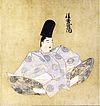 | Kunihito 邦仁 | Emperor Go-Saga 後嵯峨天皇 | 1242–1246 (4 years) Ninji, Kangen | 1220–1272 (51 years) Son of Emperor Tsuchimikado; second cousin of Emperor Shijō. Abdicated. [100] |
| 89 |  | Hisahito 久仁 | Emperor Go-Fukakusa [xx] 後深草天皇 | 1246–1260 (14 years) Kangen, Hōji, Kenchō, Kōgen, Shōka, Shōgen | 1243–1304 (61 years) Son of Emperor Go-Saga. From the Jimyōin line. Abdicated at the insistence of Emperor Go-Saga. [101] |
| 90 | 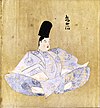 | Tsunehito 恒仁 | Emperor Kameyama 亀山天皇 | 1260–1274 (14 years) Shōgen, Bun'ō, Kōchō, Bun'ei | 1249–1305 (56 years) Son of Emperor Go-Saga; younger brother of Emperor Go-Fukakusa. From the Daikakuji line. Abdicated. [102] |
| 91 |  | Yohito 世仁 | Emperor Go-Uda 後宇多天皇 | 1274–1287 (13 years) Bun'ei, Kenji, Kōan | 1267–1324 (56 years) Son of Emperor Kameyama. From the Daikakuji line. Forced to abdicate by Emperor Go-Fukakusa. [103] |
| 92 | 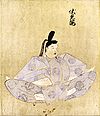 | Hirohito 熈仁 | Emperor Fushimi 伏見天皇 | 1287–1298 (11 years) Kōan, Shōō, Einin | 1265–1317 (52 years) Son of Emperor Go-Fukakusa. From the Jimyōin line. Abdicated. [104] |
| 93 |  | Tanehito 胤仁 | Emperor Go-Fushimi 後伏見天皇 | 1298–1301 (3 years) Einin, Shōan | 1288–1336 (48 years) Son of Emperor Fushimi. From the Jimyōin line. Forced to abdicate by the Daikakuji line. Traditional dates used. [105] |
| 94 |  | Kuniharu 邦治 | Emperor Go-Nijō 後二条天皇 | 1301–1308 (7 years) Shōan, Kengen, Kagen, Tokuji | 1285–1308 (23 years) Son of Emperor Go-Uda. From the Daikakuji line. [106] |
| 95 |  | Tomihito 富仁 | Emperor Hanazono 花園天皇 | 1308–1318 (10 years) Enkyō, Ōchō, Shōwa, Bunpō | 1297–1348 (51 years) Son of Emperor Fushimi. From the Jimyōin line. Agreed to alternate control of the throne between the Daikakuji and Jimyōin lines. [107] |
| 96 | 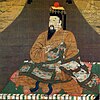 | Takaharu 尊治 | Emperor Go-Daigo 後醍醐天皇 | 1318–1339 (21 years) Bunpō, Gen'ō, Genkō (1321–24), Shōchū, Karyaku, Gentoku, Genkō (1331–34), Kenmu, Engen | 1288–1339 (50 years) Son of Emperor Go-Uda; younger brother of Emperor Go-Nijō. From the Daikakuji line. Kamakura shogunate ended in the Genkō War. Brief imperial rule during the Kenmu Restoration. Opposed the Ashikaga shogunate. Became the first emperor of the Southern Court. [108] |
| 97 |  | Noriyoshi [xxi] 義良 | Emperor Go-Murakami 後村上天皇 | 1339–1368 (29 years) Engen, Kōkoku, Shōhei | 1328–1368 (40 years) Son of Emperor Go-Daigo. Second emperor of the Southern Court. Southern Court briefly took the Northern Court's capital, Kyoto, during the Kannō disturbance. [109] |
| 98 |  | Yutanari 寛成 | Emperor Chōkei 長慶天皇 | 1368–1383 (15 years) Shōhei, Kentoku, Bunchū, Tenju, Kōwa | 1343–1394 (51 years) Son of Emperor Go-Murakami. Third emperor of the Southern Court. Abdicated. [110] |
| 99 |  | Hironari 熙成 | Emperor Go-Kameyama 後亀山天皇 | 1383–1392 (9 years) Kōwa, Genchū | c. 1347–1424 (c. 77 years) Son of Emperor Go-Murakami; younger brother of Emperor Chōkei. Fourth and last emperor of the Southern Court. Agreed to peace with the Northern Court. Abdicated in favor of the Northern Court line. [111] |
| (1) | 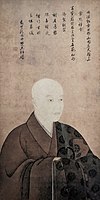 | Kazuhito 量仁 | Emperor Kōgon 光厳天皇 | 1331–1333 (2 years) Gentoku, Shōkyō | 1313–1364 (51 years) Son of Emperor Go-Fushimi; nephew and adopted son of Emperor Hanazono. From the Jimyōin line. Made the first emperor of the Northern Court by the Kamakura shogunate during the Genkō War. Deposed by Emperor Go-Daigo of the Daikakuji line. Captured by the Southern Court during the Kannō disturbance. [112] |
| (2) | 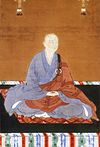 | Yutahito 豊仁 | Emperor Kōmyō 光明天皇 | 1336–1348 (12 years) Kenmu, Ryakuō, Kōei, Jōwa | 1322–1380 (58 years) Son of Emperor Go-Fushimi; younger brother of Emperor Kōgon. Made second emperor of the Northern Court by the Ashikaga shogunate. Abdicated. Captured by the Southern Court during the Kannō disturbance. [113] |
| (3) |  | Okihito [xxii] 興仁 | Emperor Sukō 崇光天皇 | 1348–1351 (3 years) Jōwa, Kannō | 1334–1398 (64 years) Son of Emperor Kōgon; nephew of Emperor Kōmyō. Third emperor of the Northern Court. Abdicated. Captured by the Southern Court during the Kannō disturbance. [114] |
| (4) |  | Iyahito 彌仁 | Emperor Go-Kōgon 後光厳天皇 | 1352–1371 (19 years) Bunna, Kōan, Jōji, Ōan | 1338–1374 (36 years) Son of Emperor Kōgon; younger brother of Emperor Sukō. Became the fourth Emperor of the Northern Court after the Kannō disturbance. Abdicated. [115] |
| (5) |  | Ohito 緒仁 | Emperor Go-En'yū 後円融天皇 | 1371–1382 (11 years) Ōan, Eiwa, Kōryaku, Eitoku | 1359–1393 (34 years) Son of Emperor Go-Kōgon. Fifth emperor of the Northern Court. Abdicated in favor of Emperor Go-Komatsu. [116] |
| (6) |  | Motohito 幹仁 | Emperor Go-Komatsu [xxiii] 後小松天皇 | 1382–1392 (10 years) Eitoku, Shitoku, Kakei, Kōō, Meitoku | 1377–1433 (56 years) Son of Emperor Go-En'yū. Sixth and last emperor of the Northern Court from 1382 until 1392. Became the legitimate emperor following Emperor Go-Kameyama's abdication. Agreed to alternate control of the throne by the Northern Court and the Southern Court. All emperors after him are from the Northern line. [117] [118] |
| 100 | 1392–1412 (20 years) Meitoku, Ōei | ||||
| 101 | 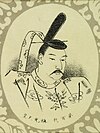 | Mihito [xxiv] 実仁 | Emperor Shōkō 称光天皇 | 5 October 1412 – 30 August 1428 (15 years, 330 days) Ōei, Shōchō | 12 May 1401 – 30 August 1428 (27 years) Son of Emperor Go-Komatsu. [119] |
| 102 | 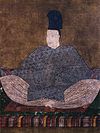 | Hikohito 彦仁 | Emperor Go-Hanazono 後花園天皇 | 7 September 1428 – 21 August 1464 (35 years, 349 days) Shōchō, Eikyō, Kakitsu, Bun'an, Hōtoku, Kyōtoku, Kōshō, Chōroku, Kanshō | 10 July 1419 – 18 January 1471 (51 years) Great-grandson of Northern Emperor Sukō; third cousin of Emperor Shōkō. Abdicated. Traditional dates used. [120] |
| 103 | 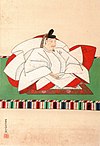 | Fusahito 成仁 | Emperor Go-Tsuchimikado 後土御門天皇 | 21 August 1464 – 21 October 1500 (36 years, 61 days) Kanshō, Bunshō, Ōnin, Bunmei, Chōkyō, Entoku, Meiō | 3 July 1442 – 21 October 1500 (58 years) Son of Emperor Go-Hanazono. Ōnin War led to the start of the Sengoku period. [121] |
| 104 |  | Katsuhito 勝仁 | Emperor Go-Kashiwabara [xxv] 後柏原天皇 | 16 November 1500 – 18 May 1526 (25 years, 183 days) Meiō, Bunki, Daiei | 19 November 1462 – 18 May 1526 (63 years) Son of Emperor Go-Tsuchimikado. Imperial rule in the Ashikaga shogunate reached its lowest point in his reign. [122] |
| 105 |  | Tomohito 知仁 | Emperor Go-Nara [xxvi] 後奈良天皇 | 9 June 1526 – 27 September 1557 (31 years, 110 days) Daiei, Kyōroku, Tenbun, Kōji | 26 January 1495 – 27 September 1557 (62 years) Son of Emperor Go-Kashiwabara. [123] |
| 106 | 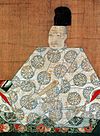 | Michihito 方仁 | Emperor Ōgimachi 正親町天皇 | 17 November 1557 – 17 December 1586 (29 years, 30 days) Kōji, Eiroku, Genki, Tenshō | 18 June 1517 – 6 February 1593 (75 years) Son of Emperor Go-Nara. Ashikaga shogunate overthrown by Oda Nobunaga. Abdicated. [124] |
| 107 |  | Katahito [xxvii] 周仁 | Emperor Go-Yōzei 後陽成天皇 | 17 December 1586 – 9 May 1611 (24 years, 143 days) Tenshō, Bunroku, Keichō | 31 December 1571 – 25 September 1617 (45 years) Grandson of Emperor Ōgimachi. Tokugawa shogunate established. Sengoku period ended. [125] |
| 108 |  | Kotohito [xxviii] 政仁 | Emperor Go-Mizunoo [xxix] 後水尾天皇 | 9 May 1611 – 22 December 1629 (18 years, 227 days) Keichō, Genna, Kan'ei | 29 June 1596 – 11 September 1680 (84 years) Son of Emperor Go-Yōzei. Japan implements isolationist policy. Purple Robe Incident led to his abdication. [126] |
| 109 |  | Okiko 興子 | Empress Meishō 明正天皇 | 22 December 1629 – 14 November 1643 (13 years, 327 days) Kan'ei | 9 January 1624 – 4 December 1696 (72 years) Daughter of Emperor Go-Mizunoo. Abdicated. [127] |
| 110 |  | Tsuguhito 紹仁 | Emperor Go-Kōmyō 後光明天皇 | 14 November 1643 – 30 October 1654 (10 years, 350 days) Kan'ei, Shōhō, Keian, Jōō | 20 April 1633 – 30 October 1654 (21 years) Son of Emperor Go-Mizunoo; younger brother of Empress Meishō. [128] |
| 111 |  | Nagahito [xxx] 良仁 | Emperor Go-Sai [xxxi] 後西天皇 | 5 January 1655 – 5 March 1663 (8 years, 59 days) Jōō, Meireki, Manji, Kanbun | 1 January 1638 – 22 March 1685 (47 years) Son of Emperor Go-Mizunoo; younger half-brother of Empress Meishō and Emperor Go-Kōmyō. Abdicated. [129] |
| 112 |  | Satohito 識仁 | Emperor Reigen 霊元天皇 | 5 March 1663 – 2 May 1687 (24 years, 58 days) Kanbun, Enpō, Tenna, Jōkyō | 9 July 1654 – 24 September 1732 (78 years) Son of Emperor Go-Sai. Abdicated. [130] |
| 113 | 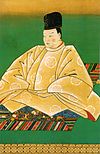 | Asahito [xxxii] 朝仁 | Emperor Higashiyama 東山天皇 | 2 May 1687 – 27 July 1709 (22 years, 86 days) Jōkyō, Genroku, Hōei | 21 October 1675 – 16 January 1710 (34 years) Son of Emperor Reigen. Abdicated. [131] |
| 114 | 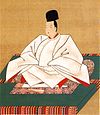 | Yasuhito [xxxiii] 慶仁 | Emperor Nakamikado 中御門天皇 | 27 July 1709 – 13 April 1735 (25 years, 260 days) Hōei, Shōtoku, Kyōhō | 14 January 1702 – 10 May 1737 (35 years) Son of Emperor Higashiyama. Abdicated. [132] |
| 115 | 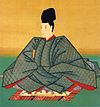 | Teruhito 昭仁 | Emperor Sakuramachi 桜町天皇 | 13 April 1735 – 9 June 1747 (12 years, 57 days) Kyōhō, Genbun, Kanpō, Enkyō | 8 February 1720 – 28 May 1750 (30 years) Son of Emperor Nakamikado. Abdicated. [133] |
| 116 | 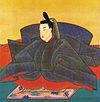 | Tōhito 遐仁 | Emperor Momozono 桃園天皇 | 9 June 1747 – 1762 (14–15 years) Enkyō, Kan'en, Hōreki | 14 April 1741 – 31 August 1762 (21 years) Son of Emperor Sakuramachi. Abdicated. [134] |
| 117 |  | Toshiko 智子 | Empress Go-Sakuramachi 後桜町天皇 | 15 September 1762 – 9 January 1771 (8 years, 116 days) Hōreki, Meiwa | 23 September 1740 – 24 December 1813 (73 years) Daughter of Emperor Sakuramachi; younger sister of Emperor Momozono. Abdicated. [135] |
| 118 | 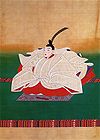 | Hidehito 英仁 | Emperor Go-Momozono 後桃園天皇 | 9 January 1771 – 16 December 1779 (8 years, 341 days) Meiwa, An'ei | 5 August 1758 – 16 December 1779 (21 years) Son of Emperor Momozono; nephew of Empress Go-Sakuramachi. [136] |
| 119 |  | Morohito 師仁 | Emperor Kōkaku 光格天皇 | 16 December 1779 – 7 May 1817 (37 years, 142 days) An'ei, Tenmei, Kansei, Kyōwa, Bunka | 23 September 1771 – 11 December 1840 (69 years) Great-grandson of Emperor Higashiyama; cousin and adopted son of Emperor Go-Momozono. Abdicated. [137] |
| 120 | 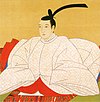 | Ayahito 恵仁 | Emperor Ninkō 仁孝天皇 | 7 May 1817 – 21 February 1846 (28 years, 290 days) Bunka, Bunsei, Tenpō, Kōka | 16 March 1800 – 21 February 1846 (45 years) Son of Emperor Kōkaku. [138] |
| 121 | 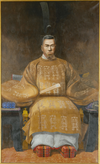 | Osahito 統仁 | Emperor Kōmei 孝明天皇 | 10 March 1846 – 30 January 1867 (20 years, 326 days) Kōka, Kaei, Ansei, Man'en, Bunkyū, Genji, Keiō | 22 July 1831 – 30 January 1867 (35 years) Son of Emperor Ninkō. Reigned during the Bakumatsu period during which Japan ended its isolationist policy and changed from Tokugawa rule to Imperial rule. Last instance of an emperor with multiple era names. [139] |
| 122 |  | Mutsuhito 睦仁 | Emperor Meiji 明治天皇 | 30 January 1867 – 30 July 1912 (45 years, 182 days) Keiō, Meiji | 3 November 1852 – 30 July 1912 (Aged 59) Son of Emperor Kōmei. Ended the Tokugawa Shogunate with the Meiji Restoration (3 January 1868). First emperor of the Empire of Japan. [140] [141] |
| 123 | 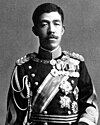 | Yoshihito 嘉仁 | Emperor Taishō 大正天皇 | 30 July 1912 – 25 December 1926 (14 years, 148 days) Taishō | 31 August 1879 – 25 December 1926 (Aged 47) Son of Emperor Meiji. Taishō Democracy shifted political power from the genrō to the Imperial Diet and political parties. His eldest son, Crown Prince Hirohito, served as Sesshō (摂政; "Regent") from 1921 to 1926 because of Taishō's illness. [141] [142] |
| 124 | 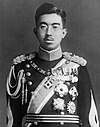 | Hirohito 裕仁 | Emperor Shōwa 昭和天皇 | 25 December 1926 – 7 January 1989 (62 years, 13 days) Shōwa | 29 April 1901 – 7 January 1989 (Aged 87) Son of Emperor Taishō. Served as Sesshō from 1921 to 1926. Last emperor of the Empire of Japan. Reign saw World War II and post-war economic miracle. Longest reigning verifiable emperor in Japanese history. [141] [143] |
| 125 |  | Akihito 明仁 | Living | 7 January 1989 – 30 April 2019 (30 years, 113 days) Heisei | born 23 December 1933 (Age 91) Son of Emperor Shōwa. Abdicated and later referred to as Jōkō (上皇; "Emperor Emeritus"). Longest living verifiable emperor. [144] |
| 126 |  | Naruhito 徳仁 | Living | 1 May 2019 – present (5 years, 304 days) Reiwa | born 23 February 1960 (Age 65) Son of Akihito. Referred to as Kinjō Tennō (今上天皇; "the Reigning Emperor") or Tennō Heika (天皇陛下; "His Majesty the Emperor"). [145] [146] |
